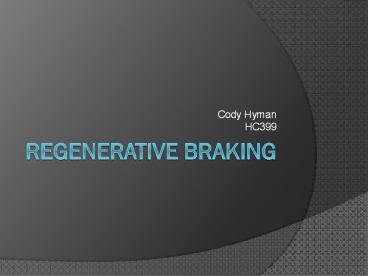Regenerative Braking - PowerPoint PPT Presentation
Title:
Regenerative Braking
Description:
Cody Hyman HC399 What is Regenerative Braking? Conventional braking systems convert kinetic energy into heat, usually via friction. This wastes a great deal of energy! – PowerPoint PPT presentation
Number of Views:6373
Avg rating:3.0/5.0
Title: Regenerative Braking
1
Regenerative Braking
- Cody HymanHC399
2
What is Regenerative Braking?
- Conventional braking systems convert kinetic
energy into heat, usually via friction. - This wastes a great deal of energy!
- Regenerative braking systems reclaim and storing
the kinetic energy in a reusable manner - Many modern electric drive vehicles including
electric locomotives and HEVs have regenerative
braking systems
3
Regen Braking Principles in Electric
Transportation
- EVs use their drive motors to convert kinetic
energy into electromagnetic energy - Motors and generators operate under the same
principle and can be used interchangeably. - The First Law of Thermodynamics dictates that the
EV will slow down as this occurs. - The generated electrical energy can be dissipated
through a resistive network (Dynamic Braking) or
stored (Regen Braking)
4
How Regen Braking WorksPart 1 The Mechanical
Aspect
- Vehicle has forward momentum
- The wheels are coupled to the rotors of electric
traction motors in an EV - Instead of a current being applied to the motor
to turn the rotors, the rotors are turned by the
wheels of the EV - The rotors experience opposing torque as current
is induced in the motor coils - This opposing torque slows the vehicle
- The generated electrical energy is stored
5
Diagram of a Regen Braking System
6
Part 2 Brake Control Circuitry
- Complex electronic circuits that handle braking
functions - Coordinates motor and friction brakes under a
wide range of situations - The controller will take the following parameters
into account and determines how the vehicle will
brake - Speed of vehicle
- Driver input (pedals)
- Storage medium state-of-charge
- Routes and regulates generated power
- Depending on the desired output, the brake
controller must be able to supply vehicle
batteries or capacitors with the proper polarity,
current, and voltage for safe charging (depends
on battery state of charge)
7
Options for storing the Energy
- Recharging vehicle battery packs
- State of charge influences how much of the
generated current can be safely stored - Ubiquitous method for hybrid cars
- Charging an array of capacitors/super-capacitors
- Pro Very high charge/discharge rate (high power
density) - Con Much lower energy density than batteries
- Allows for regen braking if batteries are at a
high state of charge - Implemented on some buses
- Non-electrical methods
- Fluid compression
- Flywheels
8
Mechanical Methods
- Hydraulic Regenerative Braking
- Slows the vehicle by compressing gas and storing
it in an accumulator - Pressure is used to assist the engine upon
forward acceleration - Potentially more efficient than electric
regenerative brake systems
A VW Beetle converted to a hydraulic hybrid that
claims up to 80 regeneration efficiency
9
Regenerative Braking in Rail Vehicles
- Dynamic Braking has been frequently used in rail
vehicles to reduce brake wear - Diesel-Electric locomotives require onboard
energy storage for regeneration - Impractical
- Some electric rail/overhead line locomotives with
regenerative braking can send power back through
supply line - Power can be received by other trains connected
to the line or sent back to the grid
10
Differences Between AC and DC Rail Lines
- AC Locomotives
- Can feed power back into the grid without the
need for large power inverters - The New Delhi Metro, after implementing
regenerative capabilities, cut down its power
consumption by 30, a total savings of 112MWh
between 2004-2007 - Other AC traction lines in the UK and NZ have
achieved improvements of 15-17 - DC Locomotives
- Cannot easily feed power back to external
networks but it can power other trains on the
same line - Efficiency depends on the number of nearby
locomotives that can receive power from
regeneration
11
DC Railway Regeneration Estimates
Energy recapture figures for DC Catenary
Locomotives
Theoretical potential Potential if additional technologies are used Potential without additional technology
Main lines 15 11 2
Regional lines 35 25 10
Local lines 45 32 16
Freight lines 20 14 3
12
Regen Braking in Road Vehicles
- Road vehicles require onboard energy storage as
well as relatively quick braking compared to rail
vehicles - Regen braking improves the efficiency in stop and
go city traffic more than high speed travel - Efficiency gains vary greatly from vehicle to
vehicle and under the driving conditions - Prius regen efficiency 30
13
Road Vehicle Efficiency Data
14
Cars with Regenerative Braking
- Toyota Prius
- Honda Insight
- Ford Escape Hybrid
- Tesla Roadster
- Chevy Volt
- It actually does have regen braking
Toyota Prius
Tesla Roadster
15
Regenerative Braking is not All That New
- The electric vehicle in this 1906 had
regenerative braking capabilities
16
Benefits of Regen Braking
- Increase of overall energy efficiency of a
vehicle - Increases vehicle range
- Cuts down on pollution related to electricity
generation - Increases the lifespan of friction braking
systems - Less use of traditional mechanical brakes leads
to less wear over time
17
The Downsides
- Added complexity of brake control system
- Only works for wheels connected to motors
- Most vehicle operation is done in 2WD
- Friction brakes are still necessary
- Safety
- Motor braking power decreases as the kinetic
energy of the vehicle decreases
18
Conclusion
- Regenerative braking is an effective method of
improving vehicle efficiency and longevity - Is already in use in many EVs
- The technology to do it exists and is often well
worth it - Mostly dependent on the wider adoption of EVs or
further development of hydraulic regeneration
systems
19
Sources
- http//auto.howstuffworks.com/auto-parts/brakes/br
ake-types/regenerative-braking.htm - http//www.hybridcars.com/components/regenerative-
braking.html - http//www.hybridcars.com/related-technologies/hyd
raulic-hybrids.html - http//www.railway-technical.com/brake1.shtml
- http//www.shorpy.com/node/5734
- http//www.railwaygazette.com/news/single-view/vie
w//regenerative-braking-boosts-green-credentials.h
tml - http//www.railway-energy.org/static/Regenerative_
braking_in_DC_systems_103.php - http//privatenrg.com/
- http//cleantech.com/news/4201/delhi-metro-earns-c
arbon-credits-re































